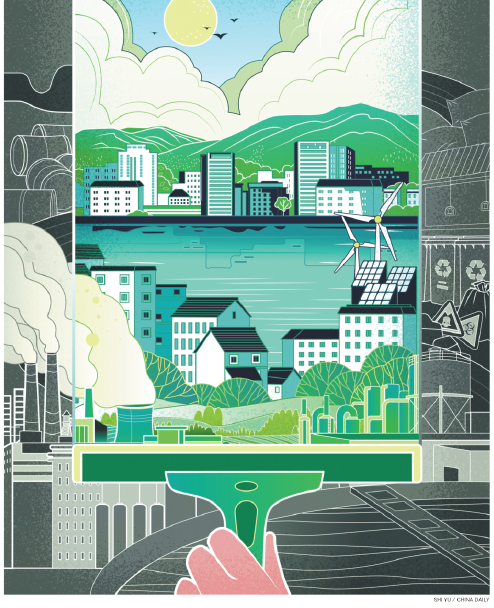Green facilities top goal of guideline


Environmental infrastructure development seen as key in urban and rural areas
China has set in motion a new set of policy measures to shore up the development of green urban infrastructure, pledging to develop a system of facilities that can better treat and monitor sewage, garbage, and solid and medical waste through 2025.
A guideline published by the National Development and Reform Commission and three other central government departments earlier this month highlighted the need to accelerate the growth of environmental infrastructure in urban areas and further modernization.
The measures marked the latest efforts to scale up investment and stabilize growth, as environmental infrastructure remains a bottleneck in national green development, analysts said.
According to the guideline, China will promote the integrated, smart and green development of environmental infrastructure and extend the infrastructure network from urban areas to rural townships and villages as it strives to improve the environment and contribute to national goals of peaking carbon dioxide emissions and carbon neutrality.
It set out a host of major targets for the development of the infrastructure, pledging to add and renovate a total of 80,000 kilometers of sewage pipes and guarantee that over 95 percent of wastewater nationwide will be treated before discharge by 2025.
Key measures include developing and improving the sewage network in urban villages, shantytowns, suburban areas and townships.
The capacity to treat household and solid waste will also be bolstered by steps like enabling the recycling of over 60 percent of household waste by 2025.
Zhao Yunhao, a researcher with the Chinese Academy of Environmental Planning, said the latest policy measures will strongly contribute to the national fight against pollution while further unleashing the market potential for infrastructure development and the growth of the environmental protection sector.
He cited official figures that showed that 4.8 trillion yuan ($758.7 billion) was spent on treating pollutants during the 13th Five-Year Plan (2016-20) period, and sales volume from environmental protection industries reached 1.95 trillion yuan in 2020.
He estimated that industries treating water pollution and solid waste and that engage in environmental monitoring could be worth 2.58 trillion yuan by 2025.
Another of the document's highlights is the proposed digitalization and green transformation of urban environmental infrastructure, which will help align environmental protection sectors with emerging technologies like big data, the internet of things and cloud computing.
The treatment of hazardous waste, especially medical waste, is a major focus of policy measures as the COVID-19 epidemic has led to mounting disposal challenges for discarded facial masks, protective gowns and gloves.
An official with the Ministry of Ecology and Environmental Protection said the government is aiming to ensure that every county develops its own system for the collection, transportation and treatment of medical waste before the end of June.
The ministry said in December 2020 that the national capacity to treat medical waste had risen by 27 percent since the onset of the epidemic.
To further enhance the capacity to handle hazardous waste, the guideline called for the construction of a host of regional treatment centers, including six focusing on the control and prevention of hazardous waste, and 20 dealing with especially unsafe materials such as medical waste.
China will also accelerate the development of a national information management platform as part of broader efforts to modernize the treatment of medical waste.
The government will encourage the use of energy-saving and low-carbon technologies and techniques during the infrastructure development process and promote the green growth of sectors devoted to the recycling of resources.
Some analysts have highlighted the significance of developing urban infrastructure and facilities that can accommodate the growing demand for garbage sorting in the near future.
Zhang Yingjian, an analyst of resources and environmental sectors at the China International Engineering Consulting Corporation, said the management of household waste is challenged by associated procedures, including collection, transportation and treatment.
He noted that the latest policy measures called for the development of a national sorting system that carries out these procedures by categorizing the waste.
Megacities including Beijing and Shanghai have already come up with regulations mandating garbage sorting. In Beijing, authorities can impose fines for violations-from 1,000 yuan to 50,000 yuan on organizations, and from 50 yuan to 200 yuan on individuals.
Tong Lin, head of the environmental sanitation engineering technology center at the Ministry of Housing and Urban-Rural Development, said trash sorting must be given greater priority, and local authorities must clarify targets and tasks and ensure implementation while bolstering the development of facilities.
Tong said it is important for authorities to move forward with the development of facilities to treat kitchen waste, including the use of proper technologies and treatment methods, and replace landfills with more environmentally friendly practices like incineration.




